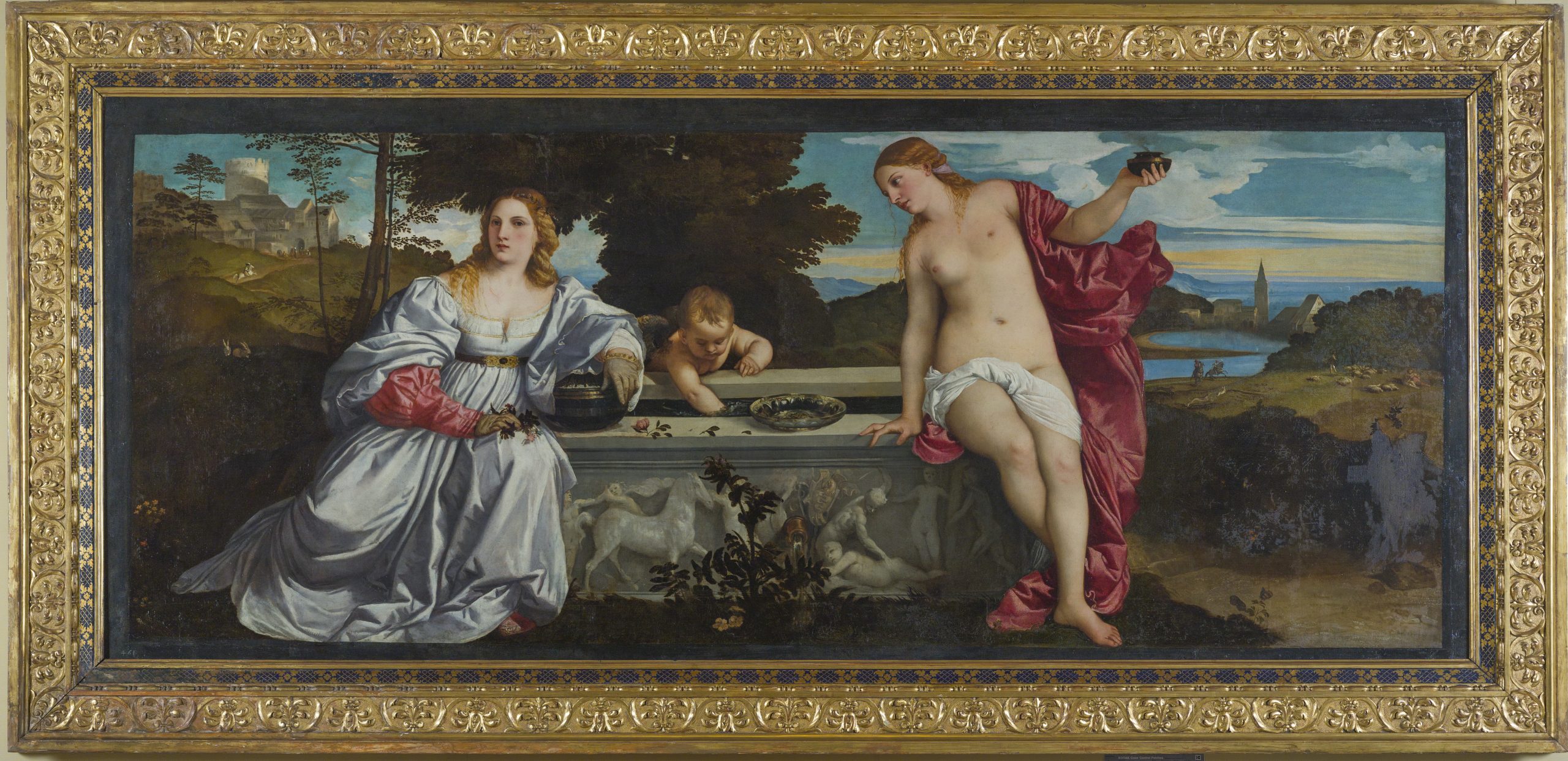Sacred and Profane Love
Titian

Sacred and Profane Love has been subject of numerous studies. Modern critics, albeit with some divergence, tend to read the painting as a marriage allegory, commissioned on the occasion of the wedding celebrated on May 17, 1514, between the Venetian Niccolò Aurelio and Laura Bagarotto: the coats of arms of the two families, placed almost in axis with each other, appear respectively on the front of the fountain/sarcophagus and on the bottom of the silver basin.
Laura was the daughter of the Paduan Bertuccio Bagarotto, who was involved in the formation of a short-lived local government hostile to the Serenissima and therefore executed in 1509 (by resolution of the Council of Ten, of which Aurelio himself had been secretary since 1507) along with his son-in-law, the Paduan nobleman Francesco Borromeo and Laura’s husband. Widowed, fatherless and deprived of her dowry, she had to agree to be united again in marriage with the man who, of a lower social class than her own, had signed the executive writ of condemnation against her family and husband. The return of the dowry took place a day before the wedding: it was the formal act that reinstated the woman’s dignity necessary for the celebration of her new marriage, redeeming her and enabling her to claim rank and role as an exemplary bride. It was perhaps this that prompted Titian to change the colour of the dress of the woman on the left, from red (as revealed by diagnostic studies conducted on the painting) to white: the colour of the bride.
Every element of the painting echoes this allegory of married love, one of Titian’s earliest.
In the centre of the composition is a sarcophagus, adorned with a classical frieze depicting a scene of the chastisement of feral love: from the left, a male figure moves a snare to a maiden grasped by the arm; in front of her stands the beautiful horse with no bridle (a symbol of uncontrolled passion), restrained by a second male figure, almost completely covered by the small central shrub; toward the right, in the presence perhaps of the maiden herself, the passionate violence is punished by flogging. The water that fills the sarcophagus transforms it into a spring, and the spout makes the meadow fertile: death is transformed into life, thanks to the generating (and tempering) force of Love, the winged maiden who stirs the waters. On the sarcophagus/fountain sit two female figures, similar enough to be considered twins. On the left, we find the woman dressed in the clothing and attributes of the bride, the belt symbolizing conjugal love as well as myrtle and little roses, attributes of Venus. At her feet the ground is a soft, flowering turf. Behind her is a landscape that echoes her meaning: there is the pair of hares (a wish for fruitful union) and the city on the hill, underscoring the civic dimension within which the marital condition is placed. On the right, the nudity of the other woman – barely covered by a white drape on her lap enriched by another, red, broader one – alludes to the sublimation of divine truth and beauty, which needs no trappings: in her left hand is a vase lit by the flame of divine love. Beside her the ground is barren, for the exercise of virtue is difficult, and rough, like a stony clearing. Behind her, beyond the hedge that encloses her symbolic space, are two horsemen intent on hunting activities, two dogs chasing a hare, a shepherd with his flock, and a pair of young lovers. In the background is a view of a village (lagoon?) dominated by a bell tower, marking the time of the everyday. The interplay of gazes between the two women eventually draws the viewer in: the nude woman turns toward the clothed one, inviting her to walk the road of virtus, difficult and separated from the world (the hedge); the clothed woman directly meets the eyes of the beholder, thus entering reality, and attesting outwardly to her dimension as woman and bride.
Sources and inventories record the two women mostly as two Venuses, but also as personifications of Sacred and Profane Love (ancient title of the painting still used today). A famous interpretation in a neo-Platonic key (Erwin Panofsky, 1939 and 1969) read them as Heavenly Venus and Vulgar Venus, or ‘earthly’ Venus, and Cupid was considered a symbol of the union of heaven and earth: which ties in well with the reading of the painting as a marriage allegory, and of the complex relationship between virtus and voluptas.
Although there is no certain information about its provenance (perhaps from the sale of Paolo Emilio Sfondrato’s collection, 1608), the work enters the Borghese collection with Scipione: it is in all likelihood already remembered in 1613 (described in Scipione Francucci’s Galleria), and it was certainly in the villa outside Porta Pinciana in 1622-23, when Antoon van Dyck drew it in his Italian sketchbook preserved in the British Museum. During the second half of the seventeenth century, like most paintings, the canvas was moved to the family palace to form the picture gallery admired by the curious and art connoisseurs. It would remain there throughout the eighteenth century and, if we exclude the trip in the retinue of Camillo and Paolina first to Turin and then to Paris between 1809 and 1816, for most of the nineteenth century. At the end of the century it will then be moved back to the villa.